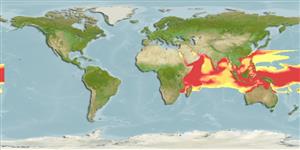Issue
This species is considered as a junior synonym of Mobula kuhlii according to White et al., 2017 (Ref. 115945:9). The species page will be removed,.
Environment: milieu / climate zone / depth range / distribution range
Ecología
marino; rango de profundidad 0 - 50 m (Ref. 106604). Tropical; 30°N - 21°S
Indo-West Pacific: Red Sea, Arabian Sea and the Persian Gulf to South Africa and the Philippines, north to Viet Nam, south to northern Australia (Ref. 9911). This species is noted as a possible synonym of the earlier Mobula diabolus (Shaw, 1804) in Compagno's 1999 checklist (Ref. 35766).
Tamaño / Peso / Age
Maturity: Lm ? range ? - ? cm
Max length : 100.0 cm WD macho / no sexado; (Ref. 6871)
Short description
Claves de identificación | Morfología | Morfometría
Brownish-grey above, whitish below (Ref. 11228). Underside of pectorals with semicircular black blotch along middle of anterior edge (Ref. 11228).
Found in coastal and oceanic waters (Ref. 30573); solitary of aggregations, sometimes with 50 or more individuals (Ref. 90102). Not known to penetrate the epipelagic zone (Ref. 9911). Feeds on plankton (Ref. 30573). Ovoviviparous (Ref. 50449).
Life cycle and mating behavior
Madurez | Reproducción | Puesta | Huevos | Fecundidad | Larva
Exhibit ovoviparity (aplacental viviparity), with embryos feeding initially on yolk, then receiving additional nourishment from the mother by indirect absorption of uterine fluid enriched with mucus, fat or protein through specialised structures (Ref. 50449).
Compagno, L.J.V., 1999. Checklist of living elasmobranchs. p. 471-498. In W.C. Hamlett (ed.) Sharks, skates, and rays: the biology of elasmobranch fishes. Johns Hopkins University Press, Maryland. (Ref. 35766)
IUCN Red List Status (Ref. 130435: Version 2024-2)
Threat to humans
Harmless
Human uses
Pesquerías: pesquerías de subsistencia
Herramientas
Special reports
Download XML
Fuentes de Internet
Estimates based on models
Preferred temperature (Ref.
123201): 25.6 - 29.1, mean 28.2 °C (based on 2136 cells).
Phylogenetic diversity index (Ref.
82804): PD
50 = 0.5005 [Uniqueness, from 0.5 = low to 2.0 = high].
Bayesian length-weight: a=0.01000 (0.00244 - 0.04107), b=3.04 (2.81 - 3.27), in cm total length, based on all LWR estimates for this body shape (Ref.
93245).
Nivel trófico (Ref.
69278): 3.4 ±0.45 se; based on food items.
Resiliencia (Ref.
120179): Bajo, población duplicada en un tiempo mínimo de 4.5-14 años (Fec assumed to be <100).
Fishing Vulnerability (Ref.
59153): Very high vulnerability (85 of 100).
Nutrients (Ref.
124155): Calcium = 26.5 [7.6, 139.1] mg/100g; Iron = 0.962 [0.235, 2.819] mg/100g; Protein = 21 [16, 26] %; Omega3 = 0.184 [0.050, 0.609] g/100g; Selenium = 50.2 [13.3, 160.3] μg/100g; VitaminA = 23.1 [7.7, 73.7] μg/100g; Zinc = 0.942 [0.449, 1.798] mg/100g (wet weight);
